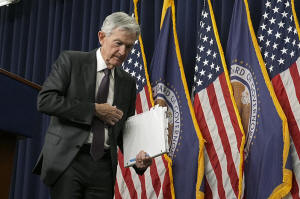Little to no relief from high borrowing costs expected as Fed Chair
Powell heads to the Hill
 Send a link to a friend
Send a link to a friend
 [February 11, 2025] By
CHRISTOPHER RUGABER [February 11, 2025] By
CHRISTOPHER RUGABER
WASHINGTON (AP) — The odds of further interest rate cuts this year by
the Federal Reserve dwindled last week as unemployment fell and more
officials say they want to see how new policies from the White House
affect the economy.
While Fed officials penciled in two rate cuts this year at their
December meeting, economists and Wall Street investors are increasingly
skeptical, with some predicting no reductions at all this year. On
Friday, economists at Morgan Stanley said they now expect just one rate
cut in 2025, and investors also expect just one — in July — according to
pricing in futures markets.
Fewer cuts could translate into a longer period of elevated mortgage
rates and high costs to borrow money for everything from autos to credit
cards. Still, mortgage rates are closely tied to the yield on the
10-year Treasury note, which can move independently of the Fed's
actions.
The shifting expectations come as Chair Jerome Powell heads to Capitol
Hill for two days of testimony this week, beginning Tuesday, before
House and Senate committees that oversee the central bank and the
financial industry. Fed chairs are required by law to appear before
Congress twice a year.
Members of Congress may urge that he cut rates more quickly. He will
also likely be grilled about issues that are taking a higher profile
under the Trump administration, such as crypto regulation, banking
regulation, and allegations of “de-banking.”

De-banking is the practice of banks shutting down customer accounts
because they believe they pose financial, legal or reputational risks to
the banks. Some crypto executives have charged that Biden administration
regulators pressured financial firms to target their industry for
de-banking.
Regarding interest rates, Fed officials have suggested recently that
after cutting their key rate three times at the end of last year — to
about 4.3%, down from two-decade high of 5.3% — they are likely to be on
hold for an extended period, though none will specify how long that
might be.
On Friday, Fed governor Adriana Kugler said that the labor market was
“stable” and that “gives us a little bit of time to make some
decisions.” She noted that inflation has "moved sideways" since the fall
and is above their 2% target.
She added that potential policy changes from the Trump administration
have added uncertainty to their outlook for the economy. Economists have
said that widespread tariffs, and the deportation of immigrants that
Trump has also promised, could push up inflation. Others argue that
Trump's deregulatory policies could, by increasing supply, reduce
prices.
“The cautious and the prudent step is to hold the (Fed's key) rate where
it is for some time,” Kugler said. "Given that the economy is solid,
given the fact that we haven’t achieved our 2% target, and given the
fact that we may have uncertainties and other factors that may be
pushing up inflation.”
[to top of second column] |

Federal Reserve Chairman Jerome Powell walks out after holding a
news conference following the Federal Open Market Committee meeting,
Wednesday, Jan. 29, 2025, at the Federal Reserve in Washington. (AP
Photo/Jacquelyn Martin)
 Separately, Austan Goolsbee,
president of the Fed's Chicago branch, said in an exclusive
interview with The Associated Press Friday that he still expects the
central bank's rate will be lower in the next 12 to 18 months than
it is now. But he also said it makes sense for the Fed to take a
slower approach as it nears a point where it may stop reducing
rates.
He also noted that the prospect of tariffs has muddied the waters a
bit for the Fed in the coming months. Tariffs may cause a one-time
increase in prices but don't necessarily cause ongoing inflation.
As a result, Goolsbee said, Fed officials will have to sort through
any price increases that do occur to determine whether they are
one-time changes, or a reflection of persistent inflationary
pressures.
“That’s not that easy to do, it’s going to take time to figure that
out,” he said. “We've still just got to wait for the dust to clear.”
Other officials also suggested that it will take time for the Fed to
determine what steps it needs to take next.
Lorie Logan, president of the Fed's Dallas branch, said Thursday
that while in “some scenarios” the Fed may soon cut rates, it's also
possible “we'll need to hold rates at least at the current level for
quite some time.”
Even if inflation were to fall close to the 2% target, she added,
that wouldn't necessarily mean the Fed should “cut rates soon."
Instead, with the economy mostly healthy and hiring holding up, the
Fed's key rate may already be close to the level at which it doesn't
restrict or stimulate growth, she said — a level that economists
refer to as the “neutral rate.”
The government said Friday that employers added a solid number of
jobs last month while the unemployment rate ticked down for the
second straight month to 4%, historically quite low. Hiring in
November and December was revised much higher.
Steady hiring and a mostly-healthy job market suggest that there is
less of an urgent need for the Fed to reduce borrowing rates. It
implemented a steep half-point cut in September after weak hiring
over the summer spurred fears that the economy was stumbling,
possibly into recession.
The jobs report “bolsters our confidence that the Fed cutting cycle
is over,” economists at Bank of America wrote in a note Friday.
All contents © copyright 2025 Associated Press. All rights reserved
 |